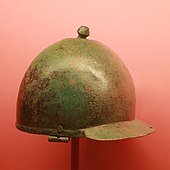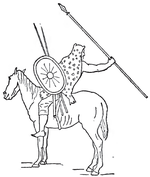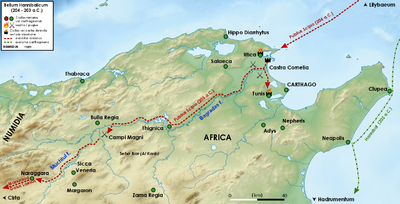Battle of Zama
At the outset of the Second Punic War, in 218 BC, a Carthaginian army led by Hannibal invaded mainland Italy, where it campaigned for the next 16 years.In 210 BC Scipio took command of the faltering Roman war effort in Iberia (modern Spain and Portugal) and cleared the peninsula of Carthaginians in five years.[29] The historian Toni Ñaco del Hoyo describes these as "great military calamities",[28] and Brian Carey writes that they brought Rome to the brink of collapse.Hannibal was still on Italian soil; there was the possibility of further Carthaginian invasions,[39] shortly to be realised when Hannibal's youngest brother Mago Barca landed in Liguria with an army from Iberia;[40] the practical difficulties of an amphibious invasion and its logistical follow up were considerable; and when the Romans had invaded North Africa in 256 BC during the First Punic War they had been driven out with heavy losses, which had re-energised the Carthaginians.[41] Eventually a compromise was agreed: Scipio was given Sicily as his consular province,[42] which was the best location for the Romans to launch an invasion of the Carthaginian homeland from and then logistically support it, and permission to cross to Africa on his own judgement.[45][47] With up to half of the complement of his legions being fresh volunteers, and with no fighting having taken place on Sicily for the past five years, Scipio instigated a rigorous training regime.[48] Also during 205 BC, 30 Roman ships under Scipio's second-in-command, the legate Gaius Laelius, raided North Africa around Hippo Regius, gathering large quantities of loot and many captives.[51] Most male Roman citizens were liable for military service and would serve as infantry; a better-off minority provided a cavalry component.Historically, when at war the Romans would raise two legions, each of 4,200 infantry – this could be increased to 5,000 in some circumstances,[52] or, rarely, even more (6,200 being the largest number recorded)[45] – and 300 cavalry.Approximately 1,200 of the infantry – poorer or younger men unable to afford the armour and equipment of a standard legionary – served as javelin-armed skirmishers known as velites; they each carried several javelins, which would be thrown from a distance, a short sword and a 90-centimetre (3 ft) shield.[71] In 204 BC, probably in June or July, the Roman army left Sicily[72] and disembarked three days later at Cape Farina 20 kilometres (12 mi) north of the large Carthaginian port of Utica.[73][75] A Carthaginian army under the experienced commander Hasdrubal Gisco and a Numidian one under Syphax set up separate fortified camps nearby.[90] The combined force is estimated at 30,000 and they established a strong camp in an area by the Bagradas River known as the Great Plains within 30–50 days of the defeat at Utica.[103][104] After Scipio overran all of Carthaginian Iberia in 205 BC, Mago had left with those forces still loyal and sailed to Liguria in northern Italy[105][103] where he recruited Gallic and Ligurian reinforcements.In 203 BC Mago marched into Cisalpine Gaul in an attempt to draw Roman attention away from North Africa, but was defeated at the battle of Insubria.[111][112] Hannibal's army sailed from Croton and landed at Leptis Minor, some 140 kilometres (87 mi) south of Carthage, with 15,000–20,000 experienced veterans.[114] The Romans retaliated by methodically capturing Carthaginian-controlled towns in Carthage's hinterland and selling their inhabitants into slavery, regardless of whether they had surrendered before being attacked or not.Scipio probably anticipated that these attacks would create pressure on the Carthaginians to dispatch an army to face him as soon as possible, rather than wait until it had recruited to maximum strength and was fully trained.However, the strength of the force left to guard their camp and continue the siege of Utica is not known, nor is the level of attrition suffered in the three major battles and several skirmishes the legions had so far been involved in.[119] Appian states that the Carthaginian army at the battle of Zama consisted of 50,000 men; this is discounted by many modern historians,[123] although some accept it with provisos.Modern suggestions include operating in close support of their cavalry, guarding the Roman camp, supplementing the velites as skirmishers or forming up as close-order infantry to one side of the legions.[146][147] The modern historian Jacob Edwards, in a study of Hannibal's use of elephants during the war, describes their deployment at Zama as "an ill-advised practice which departed from the successful tactics used previously".Edwards expresses amazement that war elephants should be so easily panicked and again suggests that at least some of the animals were "young and inexperienced at battle" making them "a liability rather than an asset".The Romans' superior weaponry and organisation eventually told and despite the hastati taking further heavy losses, the Carthaginian front rank broke and fled.This is five per cent or more of their total force; Goldsworthy considers this fatality rate "a substantial loss for a victorious army, testimony to the hard fighting" and that the battle as a whole was "a slogging match".Given the difficulty of ending the war by storming or starving the city of Carthage, and his continuing fear that he might be superseded in command, Scipio entered into negotiations.An indemnity of 10,000 silver talents[note 8] was to be paid over 50 years, hostages were taken, Carthage was forbidden to possess war elephants and its fleet was restricted to 10 warships.[180] In 149 BC, fifty years after the end of the Second Punic War, Carthage sent an army, under Hasdrubal the Boetharch, against Masinissa,[note 9] the treaty notwithstanding.The campaign ended in disaster at the Battle of Oroscopa and anti-Carthaginian factions in Rome used the illicit military action as a pretext to prepare a punitive expedition.[185] In the spring of 146 BC the Romans launched their final assault,[note 10] systematically destroying the city and killing its inhabitants;[187] 50,000 survivors were sold into slavery.
Polybius

The approximate extent of territory controlled by Rome and Carthage immediately before the start of the Second Punic War

The bowl of a
Montefortino-type helmet
, which was used by Roman infantry between c. 300 BC and 100 AD. The cheek guards are missing.

A Numidian cavalryman as imagined in 1891

Part of North Africa with Scipio's campaign shown.

A coin issued by King Masinissa

1704 French bust of Hannibal

The initial deployment of the Roman and Carthaginian armies

How a consular army would usually deploy, at Zama each maniple of
principes
deployed slightly to the left, leaving nine broad avenues through each legion.
[
145
]
Second Punic WarSiliana, TunisiaCarthagePublius Cornelius ScipioHannibalPunic WarsMercenarySecondSaguntumCrossing of the AlpsTicinusTrebiaMutinaPlacentiaVictumulaeLake TrasimeneAger FalernusGeroniumCannaeSilva Litana1st Nola2nd Nola1st Beneventum3rd Nola1st Tarentum2nd Beneventum1st CapuaSilarus1st Herdonia2nd CapuaSapriportis2nd HerdoniaNumistroCanusium2nd Tarentum2nd PeteliaGrumentumMetaurusCrotonaInsubriaEbro RiverUpper Baetis1st New CarthageBaecula1st Carteia2nd CarteiaLilybaeumDecimomannuSyracuse1st Utica2nd UticaGreat PlainsScipio AfricanusCarthaginiancapitulatedwar elephantsmainland ItalycampaignedIberiaconsulNumidianMasinissaMago BarcaRoman SenatePolybiuspeace treatyThe HistoriesScipio AemilianusCraige ChampionAdrian GoldsworthyPhilip SabinAppianCassius DioRoman eraPlutarchParallel LivestriremeOlympiasFirst Punic WarBarcid conquest of HispaniaMediterraneanSicilyNorth AfricaCarthage expanded its territory in IberiaEbro Treatysphere of influencebesieged, captured and sacked itdeclared warover the Alpsthe Trebialight cavalrySyphaxLiguriaconscript troopscenturiesmaterielmerchant shipslegateGaius LaeliusHippo RegiusRoman army of the mid-RepublicMontefortino-type helmetinfantrybetter-off minoritycavalrylegionslegionaryjavelinskirmishersvelitesheavy infantrybody armourshieldsshort thrusting swordshastatiprincipestriariithrusting spearssub-unitsmagistratesLatin alliesMilitary of Carthageclose-orderspearslight infantryphalanx
